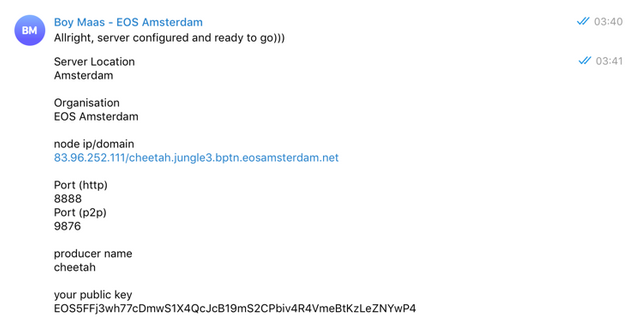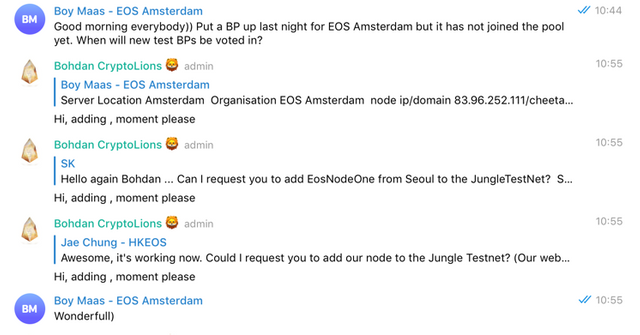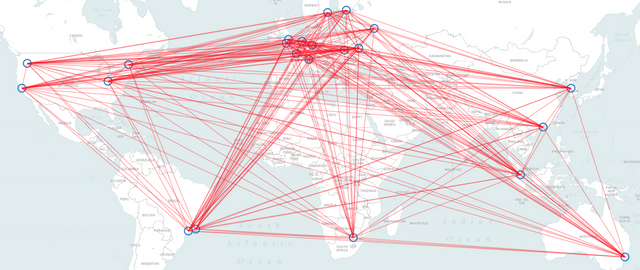EOS Amsterdam producing blocks on the Jungle3 Testnet
Shoutout for the great work of the @CryptoLions team who made it very
easy to get moving to be a part of their jungle!
For all producers wanting to join the testnet instructions can be found at: Jungle3Testnet.
On a Sunday night
Never a dull moment in the EOS community, as the channels are flooded 24x7 with enthusiasts playing around with the next releases of EOS.
Server, what to use?
Reading the web I concluded that many of the block producers are running >10 core machines with >64Gb of memory. Strange, why so many cores?
Listening to Thomas Cox in one of his latest interviews he suggested running a fast 2 core machine with a lot of memory for the first single threaded releases. Only 2 cores?? Yes! As all contract code will be processed in a single thread which made a lot of sense to me. One CPU is busy processing blocks and messages while the other CPU is essentially there to make sure the OS and supporting processes don't block.
As such I wanted to focus on fast network, redundancy and ability wanted to try something different I choose a fast 2 core machine with 64Gb of memory near the AMS backbone. Providing low latency access to 80% of Europe. If that is not a value proposition what is ;-)
I configured the machine and posted to the Jungle Telegram Channel my configuration at 3:41 in the evening. Yawn.

A good night sleep
Woke up in the morning to see if my machine was working as expected, and yes. My hardware and network connection blasted away but I was not voted in the network yet... damn.
After a message to the telegram channel, the Lions awoke and started voting in the new candidates.

And Boom after 30 minutes I am on the list :-)
Waiting for the sync
For some reason, it took a while, say 20 minutes before the new candidates started to actually produce blocks. So I was watching with a lot of concentration. And yes!

Boom! Cheetah is running wild!! See @ Jungle3 Testnet Network monitor
Inspiration for EOS Amsterdam infrastructure
It is wonderful to see how many questions were answered and how supportive the community is. It all started with the question of how to setup failover, for which I thought up an overly complex approach. See the post here.
First of all @roelandp shared with us some of his years of experience in the bit shares and steemit community running as a witness and answered the question on how to keep a block producer synched with the network without actually producing blocks.
https://github.com/roelandp/Bitshares-Witness-Monitor/blob/master/witnesshealth.py#L90
Wonderful, then Syed from @eoscafe introduced the wish to use a p2p
system to not have a single point of failure. From this came my experience with managing microservices spanning multiple datacenters.
As with p2p, you have to do leader election, which reminded me of Raft Consensus. Which put me on the track of the complete hashicorp toolset which I have worked with for years, especially Consul which brings together health checking, leader election, and multiple datacenter coordination. And Vault for handling secrets, key rotation. Why didn't I think of this before?
Boom! The coming period I will be working on designing a multiple datacenter infrastructure based on the hashicorp toolset.
The emergence of open creative people working together. Wonderfull!
The map of the Jungle Testnet
Marcin, from @EosGreen made a map of the testnet. Amazing to see how our community is organizing itself, we are covering the whole world right now. And EOS Amsterdam is proud to
be that little red circle in Amsterdam :-)

Shoutouts to our vibrant community
EOS Amsterdam is humbled to be part of this great vibrant community, shoutout again to
@eosgo for being a great source of information, and all the other candidates
mentioned in the list. And ofcourse my friend @artakush who introduced me to steemit and is always somewhere in the bush!